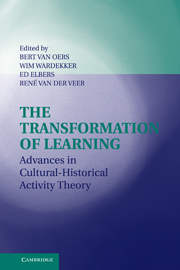Book contents
- Frontmatter
- Contents
- List of Contributors
- Preface
- INTRODUCTION
- SECTION ONE TENETS OF ACTIVITY THEORY
- SECTION TWO IDENTITY, DIVERSITY, AND INCLUSION
- SECTION THREE DYNAMICS OF ACTIVITY AND THE VARIATIONS OF LEARNING
- Introduction to Section Three: Learning in Social Settings: Challenges for Sociocultural and Activity Theory
- 15 Children's Learning through Participation in Institutional Practice: A Model from the Perspective of Cultural-Historical Psychology
- 16 Dialogue for Reasoning: Promoting Exploratory Talk and Problem Solving in the Primary Classroom
- 17 What Kinds of Tools and Resources Are Made Available to Students through Effective Guidance in a Student-Scientist Partnership Program?
- 18 Girls on the Sidelines: “Gendered” Development in Early Childhood Classrooms
- 19 Inscripting Predicates: Dealing with Meanings in Play
- 20 Pretend Play and Preschoolers
- Index
- References
18 - Girls on the Sidelines: “Gendered” Development in Early Childhood Classrooms
Published online by Cambridge University Press: 25 August 2009
- Frontmatter
- Contents
- List of Contributors
- Preface
- INTRODUCTION
- SECTION ONE TENETS OF ACTIVITY THEORY
- SECTION TWO IDENTITY, DIVERSITY, AND INCLUSION
- SECTION THREE DYNAMICS OF ACTIVITY AND THE VARIATIONS OF LEARNING
- Introduction to Section Three: Learning in Social Settings: Challenges for Sociocultural and Activity Theory
- 15 Children's Learning through Participation in Institutional Practice: A Model from the Perspective of Cultural-Historical Psychology
- 16 Dialogue for Reasoning: Promoting Exploratory Talk and Problem Solving in the Primary Classroom
- 17 What Kinds of Tools and Resources Are Made Available to Students through Effective Guidance in a Student-Scientist Partnership Program?
- 18 Girls on the Sidelines: “Gendered” Development in Early Childhood Classrooms
- 19 Inscripting Predicates: Dealing with Meanings in Play
- 20 Pretend Play and Preschoolers
- Index
- References
Summary
In my dissertation on two- and three-year-old children in a child care center (de Groot Kim, 1999), I focused on both verbal and nonverbal communication and was guided by the following broad questions: How do children make themselves understood, and how do children understand the intentions of their peers and their teachers? In this chapter, I focus on the physical activity patterns of some of the two- and three-year-old boys during transition times while they waited in the classroom to go play outside or in the hallway. It appeared that these boys regularly sent their teachers nonverbal, gender-related messages.
I will discuss (1) how socialization of two- and three-year-old boys and girls into their gender roles seemed to be influenced by the sociocultural context of their particular setting, a classroom in a childcare center; (2) how a small group of toddler boys seemed to transform unintentional physical body contact activity into intentional body contact activity, which resulted in gaining earlier access to space and resources and receiving more teacher attention; and (3) how a year later, in response to a different set of sociocultural expectations, some of the three-year-old boys seemed to transform body contact activity into a more socially acceptable, noncontact activity, aided by voice and hand gestures. They similarly gained earlier access to space and resources and received more teacher attention.
- Type
- Chapter
- Information
- The Transformation of LearningAdvances in Cultural-Historical Activity Theory, pp. 358 - 369Publisher: Cambridge University PressPrint publication year: 2008



